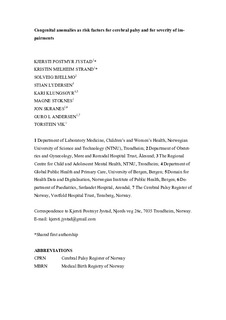| dc.contributor.author | Jystad, Kjersti Postmyr | |
| dc.contributor.author | Strand, Kristin Melheim | |
| dc.contributor.author | Bjellmo, Solveig | |
| dc.contributor.author | Lydersen, Stian | |
| dc.contributor.author | Klungsøyr, Kari | |
| dc.contributor.author | Stoknes, Magne | |
| dc.contributor.author | Skranes, Jon Sverre | |
| dc.contributor.author | Andersen, Guro Lillemoen | |
| dc.contributor.author | Vik, Torstein | |
| dc.date.accessioned | 2018-02-20T15:08:29Z | |
| dc.date.available | 2018-02-20T15:08:29Z | |
| dc.date.created | 2017-10-05T12:54:08Z | |
| dc.date.issued | 2017 | |
| dc.identifier.citation | Developmental Medicine & Child Neurology. 2017, 59 (11), 1174-1180. | nb_NO |
| dc.identifier.issn | 0012-1622 | |
| dc.identifier.uri | http://hdl.handle.net/11250/2486078 | |
| dc.description.abstract | Aim: To study the prevalence of congenital anomalies among children with cerebral palsy (CP) born at term or late preterm, and if CP subtypes and clinical manifestations differ between children with and without congenital anomalies.
Method: This was a cross-sectional study using data from the Cerebral Palsy Register of Norway and the Medical Birth Registry of Norway. All children with congenital CP born at and later than 34 weeks’ gestation in Norway from 1999 to 2009 were included. Anomalies were classified according to the European Surveillance of Congenital Anomalies classification guidelines. Groups were compared using Fisher's exact test, Kruskal–Wallis test, and the Mann–Whitney U test.
Results: Among 685 children with CP, 169 (25%) had a congenital anomaly; 125 within the central nervous system. Spastic bilateral CP was more prevalent in children with anomalies (42%) than in children without (34%; p=0.011). Children with anomalies less frequently had low Apgar scores (p<0.001), but more often had severe limitations in gross- and fine-motor function, speech impairments, epilepsy, severe vision, and hearing impairments than children without anomalies (p<0.03).
Interpretation: Although children with CP and anomalies had low Apgar scores less frequently, they had more severe limitations in motor function and more associated problems than children with CP without anomalies.
What this paper adds
• One in four children with cerebral palsy (CP) born at term or late preterm has a congenital anomaly.
• The added value of neuroimaging to detect central nervous system anomalies in children with CP.
• Children with anomalies have more severe motor impairments.
• More severe clinical manifestations are not explained by perinatal complications as indicated by low Apgar scores. | nb_NO |
| dc.language.iso | eng | nb_NO |
| dc.publisher | Wiley | nb_NO |
| dc.title | Congenital anomalies and the severity of impairments for cerebral palsy | nb_NO |
| dc.type | Journal article | nb_NO |
| dc.description.version | submittedVersion | nb_NO |
| dc.source.pagenumber | 1174-1180 | nb_NO |
| dc.source.volume | 59 | nb_NO |
| dc.source.journal | Developmental Medicine & Child Neurology | nb_NO |
| dc.source.issue | 11 | nb_NO |
| dc.identifier.doi | 10.1111/dmcn.13552 | |
| dc.identifier.cristin | 1502497 | |
| dc.description.localcode | This is the pre-peer reviewed version of the following article: [Congenital anomalies and the severity of impairments for cerebral palsy], which has been published in final form at [http://onlinelibrary.wiley.com/doi/10.1111/dmcn.13552/abstract;jsessionid=A223571B7C1AEE532E2F4FFC16A140B0.f01t03]. This article may be used for non-commercial purposes in accordance with Wiley Terms and Conditions for Self-Archiving. | nb_NO |
| cristin.unitcode | 194,65,15,0 | |
| cristin.unitcode | 194,65,35,5 | |
| cristin.unitname | Institutt for klinisk og molekylær medisin | |
| cristin.unitname | RKBU Midt-Norge - Regionalt kunnskapssenter for barn og unge - psykisk helse og barnevern | |
| cristin.ispublished | true | |
| cristin.fulltext | preprint | |
| cristin.qualitycode | 1 | |
